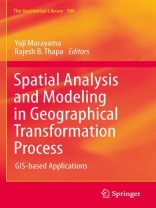Currently, spatial analysis is becoming more important than ever because enormous volumes of spatial data are available from different sources, such as GPS, Remote Sensing, and others.
This book deals with spatial analysis and modelling. It provides a comprehensive discussion of spatial analysis, methods, and approaches related to human settlements and associated environment. Key contributions with empirical case studies from Iran, Philippines, Vietnam, Thailand, Nepal, and Japan that apply spatial analysis including autocorrelation, fuzzy, voronoi, cellular automata, analytic hierarchy process, artificial neural network, spatial metrics, spatial statistics, regression, and remote sensing mapping techniques are compiled comprehensively. The core value of this book is a wide variety of results with state of the art discussion including empirical case studies.
It provides a milestone reference to students, researchers, planners, and other practitioners dealing the spatialproblems on urban and regional issues.
We are pleased to announce that this book has been presented with the 2011 publishing award from the GIS Association of Japan.
We would like to congratulate the authors!
Spis treści
Contributing authors.- Preface.-1. Spatial Analysis: Evolution, methods, and applications: Yuji Murayama and Rajesh Bahadur Thapa.- Part I: Spatial Scale, Autocorrelation and Neighborhood Analysis.- 2. Field-based fuzzy spatial reasoning model for constraint satisfaction problem: Yaolong Zhao, Yumin Zhang, and Yuji Murayama.- 3. Testing local spatial autocorrelation using k-order neighbours: Changping Zhang and Yuji Murayama.- 4. Effect of spatial scale on urban land-use pattern analysis: Yaolong Zhao and Yuji Murayama.- 5. Modeling neighborhood interaction in Cellular Automata-based urban geosimulation: Yaolong Zhao and Yuji Murayama.- Part II: Urban Analysis: Zonation and Population Structure.- 6. Estimation of building population from LIDAR derived digital volume model: Ko Ko Lwin and Yuji Murayama.- 7. Accuracy assessment of GIS based building population estimation algorithm: Ko Ko Lwin and Yuji Murayama.- 8. The application of GIS in education administration: Fatemeh Ahmadi Nejad Masouleh, Yuji Murayama, and Todd Wendell Rho’Dess.- Part III: Land Use and Land Cover Change.- 9. Accuracy of land use and land cover mapping methods: Rajesh Bahadur Thapa and Yuji Murayama.- 10. Urban dynamics analysis using spatial metrics geosimulation: Yaolong Zhao and Yuji Murayama.- 11. Modeling deforestation using a neural network-Markov model: Duong Dang Khoi and Yuji Murayama.- Part IV: Multi-criteria GIS Analysis.- 12. Land suitability analysis for peri-urban agriculture: Rajesh Bahadur Thapa Frederic Borne, and Yuji Murayama.- 13. Suitability analysis for beekeeping sites integrating GIS & MCE Techniques: Ronald C. Estoque and Yuji Murayama.- 14. Spatial allocation of the best shipping canal in South Thailand: Rajesh Bahadur Thapa, Michiro Kusanagi, Akira Kitazumi, and Yuji Murayama.- Part V: Socio-environmental Applications.- 15. Spatiotemporal patterns of urbanization: mapping, measurement, and analysis: Rajesh Bahadur Thapa and Yuji Murayama.- 16. Spatial determinants of poverty using GIS-based mapping: Brandon M. Vista and Yuji Murayama.- Index









